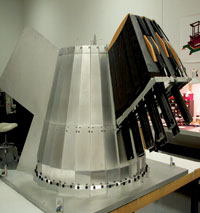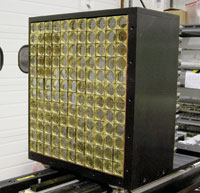2006 News Release - Big Experimental Equipment
Big Experimental Equipment
What's more, analysis of the results after the experiment has run may take another year or more to complete. In the realm of nuclear physics, such huge investments of time, energy and money to elucidate the structure of matter itself are a matter of course. Researchers' efforts are often rewarded with new information about the very building blocks of matter, and often, such results lead to questions that form the seed for the next experiment.
Here are the brief tales of three experiments, one from each of JLab's experimental halls, that focus on the equipment researchers have put together to perform cutting-edge experiments. These three stories are typical of many of the experiments that take place at Jefferson Lab - sagas that revolve around mammoth magnets, large detector packages and sophisticated electronics.

The DVCS Proton Scintillator Array was assembled by experiment collaborators from Old Dominion University. Photo credit: DVCS Collaboration
Hall A's DVCS@JLab
DVCS@JLab ran Sept. 18 - Dec. 5. The goal of the experiment is to test the theory of generalized parton distributions (GPDs). GPDs are a set of mathematical functions that may allow physicists to produce a 3-dimensional snapshot of the inner structure and dynamics of protons and neutrons in the nucleus. Physicists can use these functions to map out the location and momentum of the quarks and gluons inside protons and neutrons (nucleons). "This is the first experiment dedicated to GPDs," says Pierre Bertin, Director of Research, Laboratoire de Physique Corpusculaire de Clermont-Ferrand and lead spokesperson for DVCS@JLab.
DVCS represents "deeply virtual Compton scattering," the process these experiments used to learn about nucleons. In this process, physicists propel a beam of electrons into an experimental target. When these electrons strike the target, many collide with the protons and neutrons in the nuclei of atoms. In the first part of the experimental run, the researchers were interested in those collisions where an electron has struck a quark inside the proton, giving the quark extra energy and knocking it out of the proton. This quark then gets rid of the excess energy by emitting a photon, or particle of light, and is reabsorbed by the proton. In the second part of the experiment, researchers looked at the same process in the neutron.
For the experiment to work, researchers needed to measure the speed, position and energy of the electron that bounced off the quark, the photon given off by the quark, and the re-assembled proton. The researchers used Hall A's High Resolution Electron Spectrometer to measure the electron and a scintillator array they built to measure the proton. To measure the photon, the researchers built a new detector.
"We have built a calorimeter, a very nice one. And it is the heart of the experiment, because we need to know perfectly the energy of the photon. And at this time, we can measure that to within two or three percent," Bertin says.
Franck Sabatie is a researcher from CEA-Saclay and an experiment spokesperson. He describes the calorimeter as an array of lead-fluorite crystals. "The lead-fluorite crystals look like glass, but they're very dense -- as heavy as iron, basically," he explains. The calorimeter contains 132 rectangular crystal rods, each measuring 3 cm by 3 cm on end and nearly 20 cm in length. Attached to the end of each crystal is a photomutiplier tube.

The DVCS Calorimeter was assembled at Jefferson Lab and utilizes lead-fluorite crystals from China. Photo credit: DVCS Collaboration
"And what happens is the photon actually, as soon as it enters a very heavy material, creates an electron and positron, and these then radiate more photons," Sabatie explains, "The new photons then create more electrons and positrons... so there's a shower of particles inside the crystal.” The result is a flash of light inside the crystal, which is measured by the photomultiplier tube and recorded. “That allows us to reconstruct both the energy and the position of where the original photon hit the calorimeters" Sabatie says.
The total cost of the calorimeter tallies up to about $750,000, with the most expensive portion being the electronics package. The researchers installed the equipment in Hall A over the course of about two months and collected data on hydrogen and deuterium targets.
Bertin says that even with the new dedicated calorimeter, proton scintillator and other equipment, the analysis of the data from the experiment is going to be challenging. The researchers have already begun analyzing the data and expect to obtain results sometime in the next year.
Look for expanded versions of each of these three stories in upcoming editions of Jefferson Lab's On Target Newsletter.
Thomas Jefferson National Accelerator Facility’s (Jefferson Lab’s) basic mission is to provide forefront scientific facilities, opportunities and leadership essential for discovering the fundamental structure of nuclear matter; to partner in industry to apply its advanced technology; and to serve the nation and its communities through education and public outreach. Jefferson Lab is a Department of Energy Office of Science research facility managed by the Southeastern Universities Research Association.

